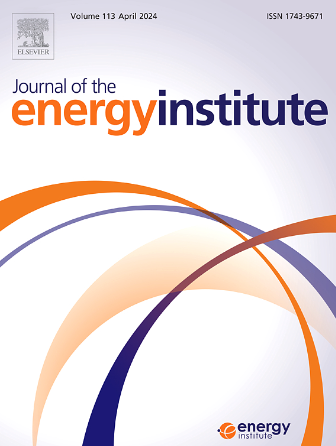Pyrolysis mechanism and gasification characteristics of actual municipal solid waste: A kinetic study through two-stage reaction models
IF 5.6
2区 工程技术
Q2 ENERGY & FUELS
引用次数: 0
Abstract
Municipal solid waste (MSW) gasification technologies represent a novel approach to waste management, while research on the kinetic characteristics and gasification behavior of actual MSW remains limited. In this paper, a new two-step kinetic model combining the segmentation of the main pyrolysis stages of MSW with Coats-Redfern (C-R) method which was more suitable for describing the pyrolysis process of actual MSW was established. Then the pyrolysis mechanism, tar generation process and the interactions among components, were thoroughly investigated based on this kinetic model. The results show the two-stage approach can effectively improve the accuracy of the MSW pyrolysis kinetic model (R2 > 0.989). The first stage of MSW pyrolysis conforms to the reaction order model, while the second stage aligns with the geometric contraction model. The average activation energies of the two pyrolysis stages are 70.49 and 120.62 kJ/mol, which demonstrated that the two-stage reaction follows different types of reactions. Gasification experiments of MSW, guided by the kinetic model, indicate that higher temperature (T > 700 °C) and equivalence ratios (ER) can promote the gasification of MSW and tar, under the optimized conditions, the H2 yield increased from 0.08 to 1.82 mmol/g, and the CO yield increased from 0.26 to 1.92 mmol/g. Further increasing the ER (ER > 0.5) can inhibit the conversion of benzene and polycyclic aromatic hydrocarbons (PAHs) by promoting the generation of CO₂. Increasing the ER and employing flue gas combustion to raise the CO₂ concentration during the gasification process is an ideal method for suppressing the formation of benzene and PAHs.

实际城市生活垃圾的热解机理与气化特性:基于两阶段反应模型的动力学研究
城市生活垃圾(MSW)气化技术是一种新的废物管理方法,但对实际城市生活垃圾的动力学特性和气化行为的研究仍然有限。本文结合Coats-Redfern (C-R)法对城市生活垃圾主要热解阶段进行分割,建立了更适合描述实际城市生活垃圾热解过程的两步动力学模型。在此基础上,对热解机理、焦油生成过程以及组分间的相互作用进行了深入研究。结果表明,两阶段法可有效提高固体垃圾热解动力学模型(R2 >;0.989)。生活垃圾热解第一阶段符合反应级数模型,第二阶段符合几何收缩模型。两个热解阶段的平均活化能分别为70.49和120.62 kJ/mol,表明两阶段反应遵循不同的反应类型。在动力学模型的指导下,城市生活垃圾的气化实验表明,较高的温度(T >;优化后的条件下,H2产率由0.08提高到1.82 mmol/g, CO产率由0.26提高到1.92 mmol/g。进一步增加ER (ER >;0.5)可以通过促进CO₂的生成来抑制苯和多环芳烃(PAHs)的转化。在气化过程中,提高ER和利用烟气燃烧提高CO₂浓度是抑制苯和多环芳烃生成的理想方法。
本文章由计算机程序翻译,如有差异,请以英文原文为准。
求助全文
约1分钟内获得全文
求助全文
来源期刊

Journal of The Energy Institute
工程技术-能源与燃料
CiteScore
10.60
自引率
5.30%
发文量
166
审稿时长
16 days
期刊介绍:
The Journal of the Energy Institute provides peer reviewed coverage of original high quality research on energy, engineering and technology.The coverage is broad and the main areas of interest include:
Combustion engineering and associated technologies; process heating; power generation; engines and propulsion; emissions and environmental pollution control; clean coal technologies; carbon abatement technologies
Emissions and environmental pollution control; safety and hazards;
Clean coal technologies; carbon abatement technologies, including carbon capture and storage, CCS;
Petroleum engineering and fuel quality, including storage and transport
Alternative energy sources; biomass utilisation and biomass conversion technologies; energy from waste, incineration and recycling
Energy conversion, energy recovery and energy efficiency; space heating, fuel cells, heat pumps and cooling systems
Energy storage
The journal''s coverage reflects changes in energy technology that result from the transition to more efficient energy production and end use together with reduced carbon emission.
 求助内容:
求助内容: 应助结果提醒方式:
应助结果提醒方式:


